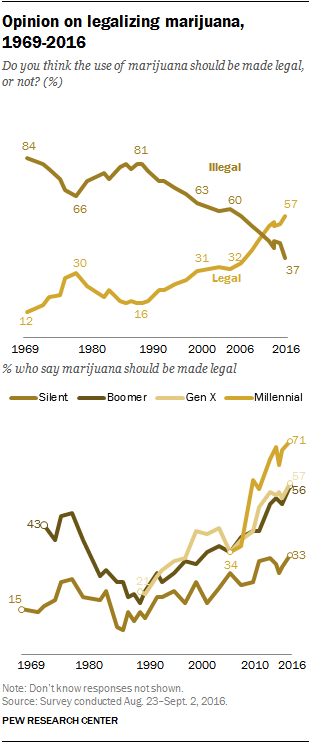Check out this great article by Tuck Sleep, who specializes in the Sleep Health field and write an in-depth article on how marijuana affects sleep that you’ll find informative. Visit Tuck Sleep’s website to learn more on everything you need to know for a great night’s sleep!
Comment on the bottom of this page to share your thoughts on how marijuana affects your sleep.
How Does Marijuana Affect Sleep?
In a recent survey of medical marijuana users, 76 percent of respondents reported using cannabis for relaxation and 65 percent as a sleep aid. The survey, conducted by HelloMD—the “largest community of patients using marijuana for health and wellness in the country”—also found that comorbid, insomnia-inducing factors were also popular reasons for weed intake: stress and depression. As many as 84 percent respondents reported that the mind-altering, psychoactive drug provides them with a significant relief of symptoms, and 96 percent of users said they’d recommend marijuana to their friends.
But do peer-reviewed studies support this enthusiasm? In this article, we take a look at the latest and most robust research regarding using marijuana for sleep.
Cannabis in the U.S.: A Recent Change in Status

In the last decade public support for the legalization of marijuana has risen drastically, some states allowed the use of marijuana for both medical and recreational purposes, and Americans began to shed the stigmas and stereotypes about those who avail themselves of the drug. Cannabis use is no longer something to snicker at, to be discreet about, or to resort to when demonizing certain demographics. Marijuana is no longer just for stoners wearing frayed denims wanting to get as high as a kite and watch Microcosmos; cannabis is also for retirees and high-performing professionals and vets who may have no interest in getting high but want to sleep soundly and without pain.
According to Pew Research Center, Americans favoring legalization of marijuana have outnumbered those against it and continue to rise. Fifty-seven percent of U.S. adults say the use of marijuana should be made legal, while 37 percent say it should be illegal—a reversal from just a decade ago. The support transcends political party and age group affiliations. One in eight Americans confesses to using marijuana. One in five people now lives near somewhere with legalized cannabis. About seven in ten Americans now believe that alcohol is more harmful than cannabis. With weed’s newfound respectability on the rise, marijuana use has increasingly become the subject of research.
Marijuana is no longer just for stoners wearing frayed denims wanting to get as high as a kite and watch Microcosmos; cannabis is also for retirees and high-performing professionals and vets who may have no interest in getting high but want to sleep soundly and without pain.“
Obstacles to the Study of Marijuana and Sleep
The users’ enthusiasm and the public’s support for marijuana notwithstanding, it has not been easy for scientists to study the effects of marijuana. It is so because legally, institutionally, and culturally embedded hang-ups remain. While more space for serious, scientifically-based conversation about the benefits and downsides of weed—including the use of marijuana for sleep—has opened up, we cannot underestimate the difficulties that federal regulations continue to pose.
Criminality at the federal level.
Cannabis is still a Schedule I controlled substance, in the same category as heroin and LSD. The American Medical Association urged the government to reclassify marijuana so that trials can be conducted more easily. For a journalistically sound expose of the difficulties involved in scientific research of marijuana’s properties, see satire-practising journalist’s John Oliver’s take from show that aired in April of 2017. “If you have marijuana right now, even if you are acting completely legally according to your state, you may still be in serious jeopardy,” Oliver pointed out. “You could lose your home, job or possessions.”
Supplier paucity.
Scientists and other critics also claim that the federal government is still ill-prepared to conduct meaningful marijuana studies. “Due to federal prohibition and regulations, all of the marijuana used for US research is provided by one facility at the University of Mississippi through the National Institute on Drug Abuse (NIDA),” write journalists at Vox. “But researchers have complained for years that the quality of marijuana that NIDA supplies is terrible—typically far below what you can get from state-legal medical or recreational marijuana markets or even the black market.”
Poor sample quality.
Researchers tasked with studying marijuana’s effects have been vocal about their frustration with the strength of the samples. The federally provided sample “doesn’t resemble cannabis—it doesn’t smell like cannabis,” lamented researcher Sue Sisley, who is conducing a federally-sponsored study about the effectiveness of marijuana as treatment for veterans with PTSD. The potency of the federally provided samples that she and many other researchers report having received did not match the strength that they requested. “It’s unclear whether mold, lead or discrepancies in potency has been a problem in prior cannabis studies, because until now, it appears that no one looked,” PBS NewsHour notes in it March 2017 investigation. In 2014, only 6 percent of studies on marijuana analyzed its medicinal properties. There’s a light at the end of the claustrophobic tunnel: In August of 2016, the DEA announced it would permit additional growers to register as producers produce of marijuana for research purposes.
Why talk about these limitations? They need to be kept in mind when we look into the results of the studies regarding marijuana’s use, including our focus here: the use of weed for sleep. Unlike with other, legal, drugs and means to fall asleep, in the case of marijuana’s use to induce restful slumber, the answers that the medical field has so far provided are partial, often contradictory, lacking clear takeaways, and very limited. Doctors and researchers are confused, too. “Clinicians,” notes the American Thoracic Society’s marijuana workgroup, “and in particular pulmonary, critical care, and sleep physicians, although called on to make important clinical judgments on behalf of patients using marijuana, are no less subject to the confusion and politicization surrounding the topic.” More robust, peer-reviewed, longitudinal research is needed.
Variations at the producer and consumer levels.
Add to all this other complicating caveats: The effects of marijuana can vary greatly from person to person. A piece of dark chocolate containing CBD and THC might relax and put to sleep one person, but it might provoke another to excessive chattiness or rumination. It is also true that producers and distributors of marijuana, where it is legal, are still tweaking the dosage and predictability of various edibles, tinctures, and the weed for smoking. With advancing regulation and quality control, much progress has already been made in states where both medical and recreational weed is legal, like Colorado, Washington, and Oregon.
What Science Tells Us Regarding Marijuana’s Effect on Sleep
While difficulties with obtaining robust samples and studies persist, researchers have reached some conclusions, some of them contested and tentative, regarding cannabis and sleep. Here are the most important ones:
- Marijuana is 114 times safer than alcohol and cigarettes. The risk of mortality that weed causes is extremely low. The findings were published in a 2015 issue of the journal Scientific Reports, which is a subsidiary of Nature.
- Smoking pot poses the same risks that smoking cigarettes does. The American Cancer Society cautions that along with THC and other cannabinoids, smoked marijuana delivers “harmful substances to users and those close by, including many of the same substances found in tobacco smoke.” The American Lung Association notes that marijuana smokers “tend to inhale more deeply and hold their breath longer than cigarette smokers, which leads to greater exposure per breath to tar. Edibles, tinctures, and oils do not pose those risks, but it’s worth keeping in mind that they can take longer to take effect—anywhere between 45 minutes to three hours. The ingestibles tends to linger longer in the system than smoked weed, which activates and dissipates more quickly.
- Marijuana may combat anxiety, but it can also provoke it. As we’ve established at the beginning of the article, many people report reaching for marijuana in order to calm anxiety and in order to fall asleep. Marijuana is derived from the hemp-producing plant cannabis and even though it contains more than 400 chemicals, the psychoactive ones are the THC (delta-9-tetrahydrocannabinol) and cannabidiol (CBD). Harvard researchers concede that at low doses, THC can be calming. At higher doses, however, it can induce “intense episodes of anxiety,” especially in people who are beginners and not used to what dosage works for them.
“The paradox of marijuana both inducing and relieving anxiety is reconciled by understanding that effects on anxiety levels are dose-dependent,” according to a scientific review of cannabis and anxiety. The Harvard-based authors of the same publication, “Medical Marijuana and the Mind,” say that CBD appears to interact with the more high-producing THC to result in sedation and that it may have independently “anti-inflammatory, neuroprotective, or antipsychotic effects, although the research is too preliminary to be applied clinically.” While a high dose taken by the unprepared might result in anxiety or even psychosis (the extreme results of a high), it is “not yet known whether marijuana increases the risk of developing a persistent anxiety disorder.” While a lot of people who smoke marijuana have anxiety, the authors of the Harvard statement say that this may be because of selection bias—meaning, marijuana is not causing the anxiety, rather, anxious people are more likely to reach for marijuana.
- The power of marijuana to induce sleep has been confirmed by a number of studies. A review of clinical trial data of the cannabis-based medicines containing primarily THC, CBD, and a 1:1 combination of the two published in the journal Chemistry & Biodiversity noted “a mild activating effect of CBD, and slight residual sedation with TCH-predominant extracts.” Authors remarked that most of the 2000 subjects that took cannabis extracts in clinical trials demonstrated “marked improvement in subjective sleep parameters,” as well as no growing tolerance to the drug over several years. In a Canadian study of 104 HIV-positive adults, two thirds endorsed the use of weed for sleep, among other benefits. In the short term, Harvard Medical School concedes, marijuana can have a relaxing effect.
Some studies, including the 2016 one from Boston University’s School of Public Health, appear to contradict these conclusions, noting that marijuana contributes to the lowering of sleep’s quality. But it may be that self-selection bias is part of the picture: people who smoke weed tend to do it because they are anxious. “Study participants who didn’t smoke every day usually smoked in the evening,” said one of the lead researchers. “But once you’re smoking multiple times a day, there’s a greater chance that you’ll report disturbed sleep. Only by stopping marijuana completely, and waiting some time without using at all, will a person be able to determine how marijuana was affecting, or not affecting, his or her sleep.”
- Studies indicate that pot can combat the ailments that can cause insomnia. Stress and depression are insomnia’s comorbidities: they can either directly keep us up or they can coexist with sleep deprivation. Among several recent studies, the one that stands out, by the neuroscientists at the University of Buffalo’s Research Institute on Addictions, examined stress and depression with particular attention on endocannabinoids, the brain chemicals similar to the ones contained in marijuana called by the researchers “brain’s own marijuana.” “Using compounds derived from cannabis—marijuana—to restore normal endocannabinoid function could potentially help stabilize moods and ease depression,” said lead researcher Dr. Samir Haj-Dahmane. Another recent study noted that pot can curb responses to triggers following severe stress and trauma (PTSD), which commonly result in startled responses, insomnia, and nightmares. The traumatized rats treated with cannabis fared much better than the rats treated with the SSRI antidepressant sertraline (Zoloft).
- CBD, pot’s non-euphoric cannabinoid, can work well as a sleep-aid in conjunction with THC or alone. Pain specialists often praise the way CBD offsets the rousing highs (and potential for psychosis) produced by THC. For some users, the more mellow indica strains of THC accomplish the task of providing the body with the unmistakable heaviness (sedation) just before falling asleep. But THC can be too rousing for many. That’s when doctors, such as James Lathrop, founder of Cannabis City, recommend CBD. “I recommend CBD to all novice users,” Lathrop says. “Certainly for people who are prone to anxiety, someone who doesn’t want that high-THC effect, the high-CBD strains can really do it.” However, some studies indicate that CBD actually induces wakefulness and decreases the beneficial slow wave and REM phases of sleep. The takeaway offered by the nonprofit dedicated to promoting and publicizing research into the medical uses of CBD is that insomniacs take a CBD-rich tincture or extract not immediately, but a few hours before bedtime find a “balancing effect that facilitates a good night’s sleep.”
- Marijuana has been shown to mitigate obstructive sleep apnea. In the June 2002 issue of the journal Sleep from the American Academy of Sleep Medicine, researchers at the University of Illinois at Chicago Department of Medicine noted “potent suppression” of sleep-related apnea in rats administered either exogenous or endogenous cannabinoids. More recent studies confirmed this effect in rats and in human adults.
- Teenagers won’t like hearing this, but use by adolescents is dangerous to brain development. Because children’s and teenagers’ brains are still forming and are thus susceptible to lasting damage, researchers caution that the detrimental effects of steady marijuana use are greater in the non-adult age group, and tend to outweigh the benefits. Susan Weiss, director of the division of extramural research at the National Institute on Drug Abuse (NIDA), notes that “there’s a growing literature, and it’s all pointing in the same direction: Starting young and using frequently may disrupt brain development.”

